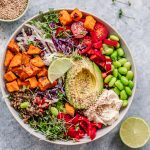Aside from the oft-cited fact that muscle tissue is more dense than fat, there are other forms of density at work in human physiology that bear consideration in personal training. Some of them are measures of food and drink before they are ever ingested.
The term nutrient density has several meanings, such as the proportion of a specific class of nutrient (carbohydrate, fat, protein) to an item’s total food energy; the ratio of nutrient composition to the body’s nutrient requirements; and, for the purpose of this article, the ratio of nutrient content to total energy content.
One way to picture that concept is to view a food that is very nutrient dense as one pole on a continuum and one that is very energy (calorie) dense as the other. The latter are often termed “empty calorie” foods because although they are high in calories, they are low in other nutrients, such as vitamins and/or minerals. Foods that are heavily processed with added sugar and fat are typically more calorie dense, but nutrient light, than foods that are minimally processed or are unprocessed.
Take, for example, the humble sugar cookie. Although it doesn’t weigh much, it packs a high number of calories from fat and sugar into a fairly compact space and so can be said to be energy dense.
At other end of the continuum are nutrient-dense foods, which are those that provide substantial amounts of vitamins and minerals and relatively few calories. Some foods high in water content (such as most melons) are relatively heavy, but have relatively few calories because water accounts for a great deal of their weight but adds no calories. Other examples include most vegetabels, which are typicallys loaded with vitamins and minerals but very few calories. Most vegetables can be said to have a high nutrient density with a low energy density since water and non-digestible fiber account for much of their mass. For those reasons, vegetables are typically a recommended part of any diet.
Returning to the sugar cookie example, for all its wealth of energy from sugar, fat, and starch, it has few vitamins and minerals and therefore can be said to have a low nutrient density. Such a food would be said to have a low caloric density.
Many foods exist somewhere in the middle of the continuum. That is, they are dense in both nutrients and calories. Compared to fresh fruits, dried fruits can pack some of the nutrients of their unprocessed counterparts, but also added sugars that contribute to their higher caloric density. Other examples of middle of the road foods include nuts and the ‘butters’ made from them (peanut, almond, cashew, etc.), seeds (sesame, sunflower), and fruits such as avocados and olives. Such foods are full of both nutrients and beneficial unsaturated fats. Here again, energy density comes into play: fat represents more food energy, gram per gram, than either protein or carbohydrates.
The old adage “You are what you eat” is largely accurate. In addition to weight gain, a sustained diet high in energy dense foods that are low in nutrient density can lead to nutrient deficiencies. That’s something to keep in mind when making informed dietary choices.
References
http://www.health.gov/dietaryguidelines/dga2005/document/
Darmon, Nicole, et al. “A nutrient density standard for vegetables and fruits: nutrients per calorie and nutrients per unit cost.” Journal of the American Dietetic Association 105.12 (2005): 1881-1887.
Miller, Gregory D., et al. “It is time for a positive approach to dietary guidance using nutrient density as a basic principle.” The Journal of nutrition 139.6 (2009): 1198-1202.






